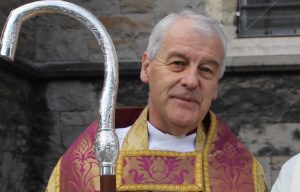Christmas 2023 is different yet again. It is different for a very particular reason. The Land of The Holy One (The Holy Land) is sacred space to three World Faiths: Judaism, Christianity and Islam. It is a war zone, in the assessment of everyone, as never before in recent history. In the face of horrific loss of life on two political and cultural fronts, whatever the rights and the wrongs of strike and response, whatever the antecedents and the self–understandings that make current history happen as it unfolds, the human dismemberment of whole societies is an affront in a world of international sophistication, international diplomacy and international communication. The denial of the designation ‘innocent’ to vast tracts of any population by anyone begs the question about international capacity to challenge powerful opportunisms and military tyrannies. It is the incapacity collectively to rein in both sides that saps the energy from the powerless onlooker (How many people have said to you or me: I switch it off, I can no longer look at it?); it is the same incapacity that weakens the international experiment in being politically mature as nations. It is a background such as this that challenges our language of progress, civilization and ecology. And this is because ecology is something organic. It is not exclusively about the natural world from which we as human beings have separated and superioritized ourselves right from the beginning of progress itself. It is about the viability of world living. Many people have grown tired of the: Never again … trope, because there seems always to be an: Ever again …The tent pegs of theological discernment and religious interpretation have long ago disappeared and self–privatized from our societies. We are left facing our raw selves in the face of The Other for whom we can make little space. It is a most uncomfortable place to be, particularly at Christmas, for any of us and still, living where we do, we are shielded from the true horrors of it.
Celebrating The Prince of Peace in The World of War is the right thing to do. I say this because of the stubborn conviction that good does not triumph over evil; neither is the light extinguished by the darkness. This is the Christian hope and, equally important, as Hebrews 11.1 says: Faith gives substance to our hopes and convinces us of realities we do not see. All the evidence, all the information and the misinformation we receive make it a hard call or, as they say, a tough gig this year of all years. The Patriarchs and Heads of Churches in Jerusalem struck a chastening note as far back as November 10 this year in encouraging the world to celebrate Christmas in a spiritual way more than in a material way, mindful of the plight of their place and their people. This is only right and we stand in solidarity with them. Many of you will have seen the Lutheran crib with a child lying in a rubble of broken stones. The bedrock of our shared hope, nonetheless, is that the light does not cease to shine.
When we turn to The Gospel for Christmas Day, we recognize that this Gospel Reading is similarly inextinguishable in terms of its impact on the self–understanding of the church. There is always something more to find in it. Its pellucid sparseness and its economic thinness open up new pathways for the spiritual imagination on a regular and repetitive basis. And repetition itself is intrinsic to faithfulness. For us in Christ Church Cathedral, the selection of this Reading is an annual invitation to explore what it is for God to live on earth in human form as the earth itself changes and as humanity changes. The eternal and the transient need to meet and, through their mutual incomprehension of one another, find a third way forward again and again. This is another worthy repetition. St John 1.1–18 sets out themes and vistas with very little narrative and with very few human characters. The absence of too many actors and their Agendas gives us scope for building a church in our societies where we need to write ourselves and others into the narrative. Apathy and passivity along with aggression and power–grabs are part of church and society. But neither church nor society is a spectator sport. The common good is ever crying out for the sort of engagement which builds on a bedrock of self–understanding. It is such self–understanding that defies the echo chamber of self–delusion. It is our opportunity to write the narrative of Christianity into the narrative of today’s world through our actions and our attitudes. And so, as we read between the lines of The Prologue of St John, we are writing the Christmas story for today.
There are very few people involved. We would do well to take note of the fact that fewer people need to speak incessantly than is the case today in situations of every type to which we have become accustomed. This can teach us to give space to personalities who fade or are only glimpsed fleetingly or from afar, the sort of people who are reticent and invisible, unknown and yet are iconic in pointing to real life situations about which others neither know nor care. They are the people who have been given voice not so much by the churches but by Samuel Beckett and they form a significant body in the life of our society nationally and internationally. Whether they be victims of war, displaced persons, refugees, families and individuals who have fallen below the poverty line and simply cannot rise above it ever again, children, women and men young and old, they now have a part in the living heritage of world understanding through the writings of Samuel Beckett. They feature enigmatically but profoundly in The Christmas Story of St John as well.
There is no mention of Mary in St John’s Christmas Story. It is not so much that she is Tipp–Ex–ed out, she simply does not feature. Once again, a contemporary generation undoubtedly finds this hard to comprehend. We think in terms of celebrities and competing in their cult of personal self–promotion. Mary, The Mother of God, does not need to feature in St John. St John challenges us to envisage Emmanuel (God with us) without shepherds, hillside, manger and mother. Rather, the story of incarnation is told from the perspective of on–going discipleship, being born: but of God. (St John 1.13) Belonging is radically transformed by setting to one side the conventional ways of being and of belonging: born not of human stock … Incarnation, God becoming a human being, is already in this Gospel about those who accept Jesus Christ being children of God. Salvation is the purpose of incarnation. This is not a process of accumulating worthiness. This is a direct gift from God to those who accept and trust. This is a new incarnation in each one of us. It is a totally different, but also totally this–worldly, way of looking at the impact of Christmas.
Moses and John the Baptizer both feature. And they are really the only two known personages who do. What is interesting here is that they do not feature in any other accounts of the birth of Jesus. (But if you really are theologically curious you will notice that St Mark’s Gospel begins with John the Baptizer and St Mark’s Gospel has no birth narrative either.) Once again, in our crowded world, where more often than not we crowd ourselves and one another out, it is important to keep our eyes open for people whom we might not ordinarily see in obvious circumstances. Both Moses and John are prophets and, of course, Jesus Christ The Word of God is a prophet. It surely is interesting and important for us to see what happens to them both. Moses does not last. He is compared with Jesus in the following way: the law was given through Moses, but grace and truth came through Jesus Christ. St John’s Gospel has a sense of urgency. The law has had its function. It has its built–in limitation; grace upon grace and grace and truth however came through Jesus Christ. Only God is God. This is what Christmas is. It is at verse 17 we get closest to a conventional birth narrative by the mention of the name Jesus Christ rather than The Word.
John the Baptizer lasts a bit longer than Moses. As a living prophet with earthly followers, he has a job of work to do in the handing on of both prophecy and discipleship to the incarnate Word of God. He has been the last of the custodians of that Word, after all. The Gospel is very clear about his role. It is well defined and well expressed. He will fade from the scene, as indeed he does in the other Gospels, but he has essential work to do before he does. He is described as being sent from God, as someone who witnesses and testifies to the light and with the purpose that through him all might believe. This is a substantial task. Again, this role points us to the powerful contribution of the intermediary, the person in–between, the sort of person who can share generously the best of the old world and, in the same breath, usher in the hope of the new world without bitterness or undue self–interest. Those who prepare the way, those who have made and continue to make the present possible are often forgotten. Here we see one such person honoured. To find out more about how the movement from John to Jesus happens, you will have to read on. But, again, the easy transition which St John foregrounds in the person of John the Baptizer shows us how we often forget the life–giving contribution of those who ease and facilitate transition without drawing any attention to themselves. Neither do they feel the need to force themselves into its dividend. John’s function is complete when he speaks out who The Word is and what his function is: The Lamb of God who takes away the sins of the world; this is the work of salvation, death, victory over death, sacrifice and standard bearing. Only God can do it.
Why build a portrait of Gospel, a jigsaw of Good News out of the invisible, the forgotten, the fleeting? The creation concerns God and those who know they are not the big picture and who do not take the centre stage. It is they who point us to our place in this big picture; and we ought to take heart from them. They are not non–entities; they are facilitators of the unfolding of God. I suggest, without insult to you or to me, we ought to take heart precisely because this is because this is who we are most of the time and most of our lives: consequential and invisible. It is the opposite of the contemporary celebrity culture. But it is an essential rebalancing that Christmas Day offers us as a gift.
The images of our world from our partner–Diocese are of a place where children have their names written on their legs by their parents in the hope that when they are killed they might be returned to their parents for burial; where hospitals are places where sanctuary is not assured; where festivals are held at which young people are not safe from being brutally murdered; where a household kitchen in a community kibbutz becomes a blood–stained murder scene. Our world is one where we deal increasingly in the claustrophobia of incompatible cultures, the trading in legitimacy regarding death itself. This is an horrific world. And then there are the wars and the people that are forgotten: Nagorno Karabakh; Russia and Ukraine, The Yemen, The Democratic Republic of The Congo and vast tracts of Africa. And let us not forget our own neighbourhoods and the neighbourhoods of others.
Of all people, we do well to hold fast to The Christmas hope and to make it happen:
St John 1.5: The light shines in the darkness, and the darkness has never mastered it …










